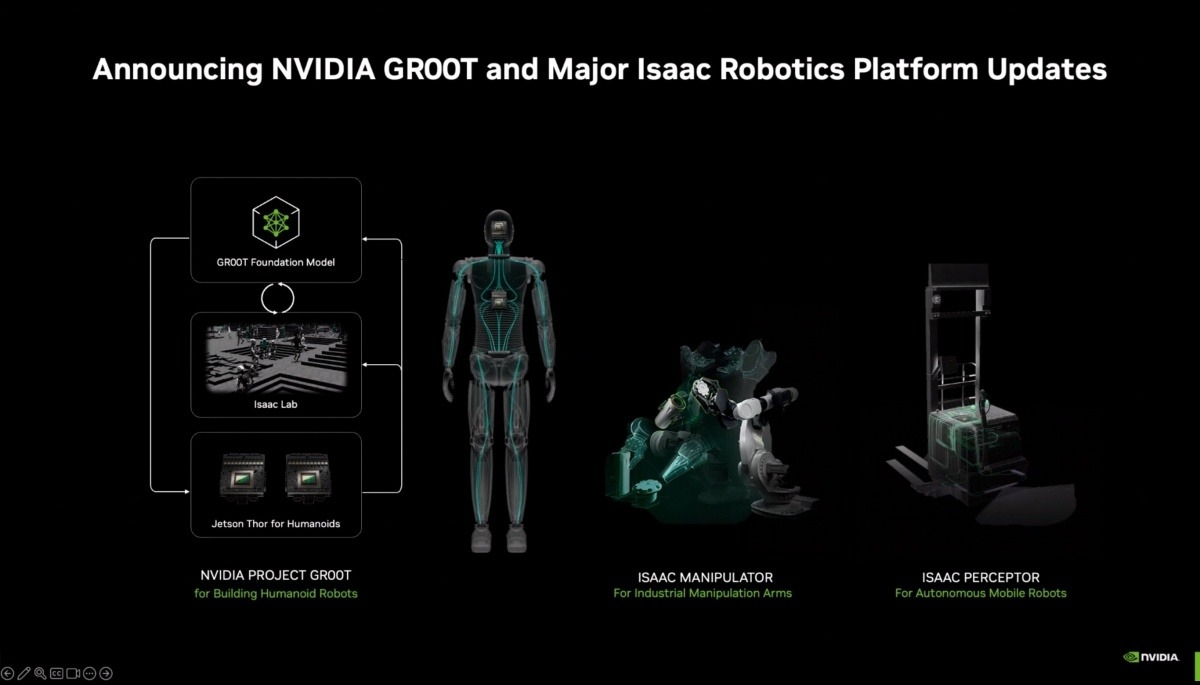Embracing the Future: Nvidia’s Project GROOT and the Evolution of Robotics

In the realm of cutting-edge technology and innovation, Nvidia has once again captured the spotlight with its latest venture, Project GROOT. This ambitious project introduces a fully humanoid robot poised to rival Tesla’s Optimus AI robot, marking a significant leap forward in the field of robotics and artificial intelligence (AI). Nvidia’s foray into humanoid robotics underscores its commitment to pushing the boundaries of technology and shaping the future of human-robot interaction.
Unveiling Project GROOT
Project GROOT represents a bold step for Nvidia, showcasing its prowess in developing advanced robotics solutions. The creation of a humanoid robot capable of competing with Tesla’s Optimus AI robot highlights Nvidia’s dedication to innovation and excellence in the robotics sector. By leveraging state-of-the-art technologies and expertise, Nvidia aims to revolutionize the landscape of robotics and AI, paving the way for new possibilities and applications.
The Role of Generative AI
In conjunction with Project GROOT, Nvidia has introduced the ACE Production Microservices, incorporating generative AI models into applications such as Nvidia Audio2Face and Nvidia Riva Automatic Speech Recognition. This integration of generative AI signifies a significant advancement in human-robot interaction, enabling more natural and intuitive communication between humans and robots. By collaborating with industry leaders like Boston Dynamics and Collaborative Robots, Nvidia is at the forefront of shaping the future of robotics through innovative technologies.
Implications for the Future of Work
The emergence of Project GROOT and Nvidia’s focus on generative AI in robotics have far-reaching implications for the future of work and technology. As AI and automation continue to transform industries and job roles, advancements in robotics technology are poised to revolutionize how humans interact with machines. The integration of humanoid robots like those developed through Project GROOT could lead to enhanced productivity, efficiency, and collaboration in various sectors.
Embracing Innovation
In conclusion, Nvidia’s Project GROOT represents a significant milestone in the evolution of robotics and AI. By pushing the boundaries of technology and embracing innovation, Nvidia is shaping the future of human-robot interaction and redefining possibilities in the realm of robotics. As we look ahead to a future where humanoid robots coexist with humans in various capacities, Nvidia’s groundbreaking initiatives serve as a testament to the transformative power of technology in driving progress and shaping a brighter tomorrow.

The Impact of AI and Automation on the Future of Work and the Human Workforce
In today’s rapidly evolving technological landscape, the integration of artificial intelligence (AI) and automation is reshaping the future of work and posing both opportunities and challenges for the human workforce. As advancements in AI and automation continue to accelerate, it is crucial to understand the implications of these technologies on the workforce and how individuals and organizations can navigate this transformative period.
Opportunities and Challenges
The integration of AI and automation is expected to create new job opportunities across various industries, with estimates suggesting the potential for millions of new jobs in emerging fields such as data science, AI development, and robotics. These technologies have the capacity to enhance efficiency, productivity, and innovation, leading to economic growth and improved business outcomes.
However, the rise of AI and automation also presents challenges, particularly in terms of potential job displacement and the need for reskilling and upskilling to adapt to changing job requirements. Traditional job roles may be at risk of automation, leading to concerns about job security and the impact on the workforce. As AI continues to evolve, there is a growing emphasis on the importance of continuous learning and development to remain competitive in the job market.
Shaping the Future of Work
The future of work is likely to be shaped by the increasing integration of AI and automation, which has the potential to transform industries, business processes, and job roles. AI-driven technologies are revolutionizing how tasks are performed, leading to greater efficiency, accuracy, and scalability in various sectors. From predictive analytics to robotic process automation, AI is driving innovation and changing the way we work.
As organizations embrace AI and automation, there is a growing focus on the need for human-machine collaboration, where humans and machines work together to leverage their respective strengths. This collaborative approach can lead to enhanced decision-making, creativity, and problem-solving, ultimately driving business success in the digital age.
Adapting to the Changing Work Landscape
To thrive in a world increasingly influenced by AI and automation, individuals and organizations must adapt to the changing work landscape. This involves investing in skills development, embracing lifelong learning, and fostering a culture of innovation and agility. By staying abreast of technological trends, honing digital skills, and cultivating a growth mindset, individuals can position themselves for success in the evolving job market.
Organizations, too, must prioritize workforce development, reskilling employees for roles that complement AI and automation, fostering a culture of continuous learning, and promoting diversity and inclusion in the workplace. By embracing change, fostering creativity, and leveraging the potential of AI and automation, businesses can drive growth, innovation, and competitiveness in the digital era.
Conclusion
In conclusion, the integration of AI and automation is reshaping the future of work and the human workforce, presenting both opportunities and challenges for individuals and organizations. By understanding the impact of these technologies, adapting to the changing work landscape, and embracing a culture of innovation and lifelong learning, we can navigate this transformative period and harness the potential of AI and automation to drive success in the digital age.







